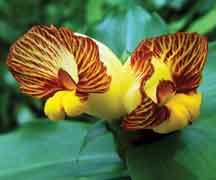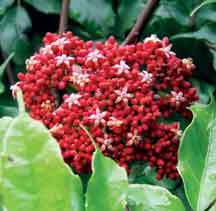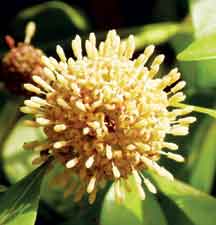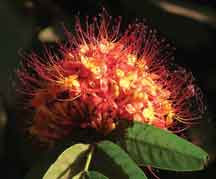Katie Bagli
“What is this life if, full of care,
We have no time to stand and stare?
No time to stand beneath the boughs,
And stare as long as sheep and cows” – W. H. Davies
 When the seeds of Tree Appreciation Walks (TAW) were sown in our minds (a group of seven nature-loving friends), we had probably put ourselves in WH Davies’ shoes. We used to regularly visit the green pockets of Mumbai to explore the different types of flora; there was so much to learn about it, so much to fascinate us… it unleashed a great thirst for knowing more and more. But, it was not enough to keep this knowledge to ourselves.
When the seeds of Tree Appreciation Walks (TAW) were sown in our minds (a group of seven nature-loving friends), we had probably put ourselves in WH Davies’ shoes. We used to regularly visit the green pockets of Mumbai to explore the different types of flora; there was so much to learn about it, so much to fascinate us… it unleashed a great thirst for knowing more and more. But, it was not enough to keep this knowledge to ourselves.
“If you would thoroughly know anything, teach it to others.” – Tryon Edwards
There are so many tree lovers, we realized, who unfortunately haven’t had the chance to learn much about trees. The more you know about the tree the more you can connect with it. Thus, we began conducting once-a-month tree walks for anybody and everybody who cared to join in.
Our aim was not to just bombard our participants with the knowledge we attained from various sources – books, the internet, botanists – but to kindle a passion for the verdant green and to inspire them to explore and discover more on their own.
So it was that an average of fifty expectant participants would attend our walks every month, many of them becoming regulars. But who, you may ask, were the participants? A fair cross-section of society that includes doctors, housewives, teachers, students, photographers, professors of Botany, officials of the Tree Authority and many more.
 To reach out to all our participants we maintain a record of their contact details and have even set up a TAW Yahoo group that enables us to announce our tree walks, to forward our report on each walk and to enable the participants to become proactive and give them a platform to express their feedback and even share photographs or any information of interest on plants with the group.
To reach out to all our participants we maintain a record of their contact details and have even set up a TAW Yahoo group that enables us to announce our tree walks, to forward our report on each walk and to enable the participants to become proactive and give them a platform to express their feedback and even share photographs or any information of interest on plants with the group.
But before each scheduled walk, it becomes imperative to do some groundwork. So three to four recces of the venue are undertaken during which a trail is chalked out such that it covers the most interesting plants, which may be flowering or fruiting – they may be trees, shrubs, herbs or climbers and creepers.
To be able to satisfactorily answer our participants’ queries it is necessary to have a fair amount of knowledge ourselves, and so no effort is spared in unearthing information from a variety of sources.
In addition, to arouse the curiosity of our participants we forward them photographs of the plants that they will see during the walk and even send out the list of plants that are to be shown, giving the common names, the scientific names, the family names and the country of origin.
 During the walk itself, all possible aspects of the plants are covered, to make it interesting to one and all:
During the walk itself, all possible aspects of the plants are covered, to make it interesting to one and all:
The morphological aspect – a balance is maintained, avoiding too many details, but explaining enough for all to understand. For instance, why does a flower have a particular shape and markings? Does that make it easier for its pollinator – the insect, bird or bat – to reach the nectary and simultaneously transfer the pollen brought from another flower? Why do some plants have tiny leaflets while others have enormous leaves?
The mythological aspect – for instance, how did the Assan tree get spines on its trunk? As the folklore goes, Lord Bhishma had impaled a lizard on this very tree with his arrow, and so the cold-blooded creature cursed him such that he too may die on a bed of thorns made out of the Assan tree and so the latter sprouted spines.
 Any interesting historical connections – for instance, the British had grown a living barrier of the impenetrable thorny Karvanda plants interspersed with customs houses right from West Bengal to Punjab to prevent the smuggling out of salt by Indians who wanted to avoid paying salt tax. This barrier made its mark in history and was known as the Great Indian Hedge, compared by some to the Great Wall of China.
Any interesting historical connections – for instance, the British had grown a living barrier of the impenetrable thorny Karvanda plants interspersed with customs houses right from West Bengal to Punjab to prevent the smuggling out of salt by Indians who wanted to avoid paying salt tax. This barrier made its mark in history and was known as the Great Indian Hedge, compared by some to the Great Wall of China.
Any interesting stories connected with the tree — like the one about the pioneers who campaigned for the large scale cultivation of Jackfruit – PlavuJayan (which means Jackfruit Tree Jayan) in South India, and Kos Mama (Jackfruit Uncle) in Sri Lanka. They brought home the realization, to the masses, of its immense nutritional value and not only curbed environmental degradation that would result from exhaustive cultivation but also stemmed the dominance of cash crops.
It could even be the spiritual aspect, such as how Lord Buddha attained nirvana while meditating under the Peepal tree.
Of course, the one most common question that always raises its head in the human mind is of what use could the particular plant be to us; so we endeavour to answer this too during our TAW; the medicinal value, the food value, the economic value, whether used in cosmetics or aromatics… the list is endless.
To increase the impact of the walks, the biodiversity seen around the plant is discussed: such as insects, reptiles, birds and mammals and their relationships with the plant. In addition, the participants are also shown specimens of fruits and seeds and pressed plants as the trees bear seeds and fruits only in certain seasons.
The scientific names of plants would sound like gibberish to our participants unless they are explained its meaning or its origin. So we do not refrain from telling them about it – for instance the Stercula feotida (Junglee Badam tree) got its name from the Roman God of manure, Sterculus and ‘foetida’ refers to the unpleasant smell of its flowers. This makes it easy to remember the names even for those who have not studied science.
It goes without saying that the above methods of teaching would only be effective if they came from the heart. Our passion and sincerity should be infectious enough to spread to others. Besides, they should feel the confidence to go exploring on their own and even undertake tree trails in their own residential areas.
In this, we are happy to say that our goals have been achieved. Various participants of TAW are now able to identify trees themselves and have now begun their own TAWs. Amongst them is Rama Bishnoi, vivacious and vibrant, she has now begun conducting similar Tree Appreciation Walks in her own locality and has been appealing to the other participants to do so too.
So also have Seema and husband Harsha Nitsure – they are now taking tree walks on a similar pattern in Thane where they live.
At the time of writing we have completed 29 walks spanning the different seasons – the searing heat of summer, the pleasant spring with its promise of new life, the grey and wet monsoons, the cold and dry winter; and we have no intention of stopping.
What drives us on month after month? There are various reasons. The walks are a great learning process for us too. But the most important factor is the warmth and gratitude we get from our participants which endow us with more than required encouragement and a great sense of fulfilment.
The author has been a volunteer with Bombay Natural History Society for the past 9 years. An ardent nature lover, she is always happy to be a nature guide and is a published author of children’s story books on nature, and magazine and newspaper articles. The author has written this article on behalf of the Tree Appreciation Walks team. She can be reached at katiebagli@yahoo.co.in.
